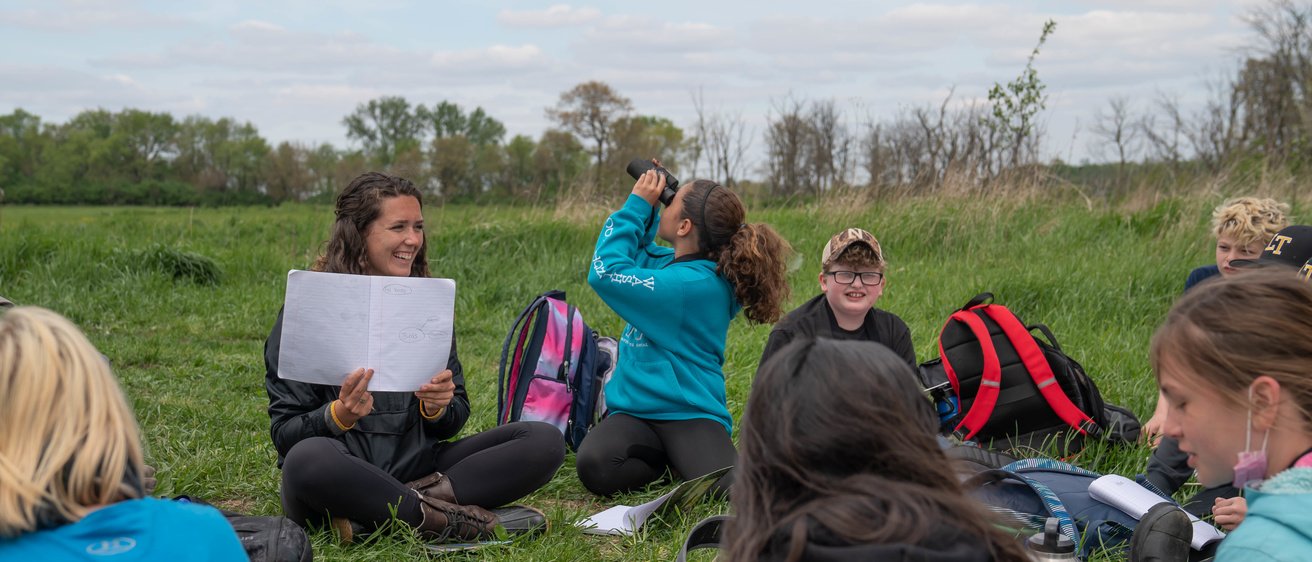After spending over a year indoors, kids were ready to get outside with School of the Wild.
School of the Wild is a conservation education program at the University of Iowa College of Education, teaching youth about the habitats of Iowa and the importance of protecting and caring for their environment.
“They get to see something that is truly interdisciplinary. They are seeing students doing science in the prairie, while picking up on the history of Iowa prairies. Then students are journaling as they go, while getting the physical aspect of hiking. It’s very authentic experiential learning, it’s not theoretical,” says School of the Wild Director Jay Gorsh.
Gorsh got involved with School of the Wild while completing his Ph.D. in special education at the College of Education.
“Having been a former teacher, I loved the idea of teaching in an outdoor setting instead of a traditional classroom environment and recognized the need for kids to have that opportunity so I wanted to make sure that could happen and be part of that happening for more kids,” says Gorsh.
The program started more than 20 years ago by David Conrads, who wanted to bring the experience of Iowa Wildlife Camps into the school year. Elementary and middle school students are invited to take part in excursions for one week of school, focusing on ecology, natural history, personal growth, and team building.
School of the Wild is one of three programs under the broader umbrella of UI WILD (Wildlife Instruction and Leadership Development), which moved from UI Recreational Services to the college in August of 2021. Iowa Wildlife Camps and the Iowa Raptor Project are the two other programs. UI WILD is dedicated to providing experiential learning opportunities for all students across Iowa. Read a related story.
School of the Wild started with just five Iowa City schools. Now, every sixth-grade class in the Iowa City Community School District spends a week at School of the Wild.
2021 was the first year an entire graduating class did not get to participate in School of the Wild. While Iowa City students did not get to participate in the program due to district safety protocols, COVID-19 allowed Gorsh to bring School of the Wild to schools across Iowa.
Due to district COVID-19 safety protocols, last year was the first year an entire class did not get to participate in School of the Wild. However, Gorsch was able to bring School of the Wild to over 20 other school districts, utilizing county and state parks across Iowa, serving 1,249 students.
“As we’ve gone through generations, we’ve become less and less connected to our natural environment,” says Gorsh. “When you get a chance to spend time in the outdoors, it has a positive impact on physical and mental health.”
School of the Wild is not only beneficial to K-12 students, it also provides future teachers with the opportunity to take their learning outside of the classroom.
“It’s been a great partnership with the College of Ed. The faculty and the dean really understand the benefits and need for our program and have given us incredible opportunities, like student teaching,” says Gorsh.” It’s unheard of to spend eight weeks of your student teaching in an outdoor environment.”
Abbie Craig (BA ’21 Elementary Education) got to do just that, spending her student teaching semester teaching kids across Iowa about nature and conservation.

“One of my favorite things about School of the Wild is the questions that we get, and we can see the wheels starting to turn when they start to see things and the connections between them,” says Craig.
Craig is excited to take what she learned in School of the Wild into her second grade classroom at South Prairie Elementary School in Grimes, Iowa.
“I want to encourage questioning and exploring in my students.,” Craig says. “Kids need to be able to apply what they are learning. If they don’t feel like it’s real, they don’t think it’s worthwhile to learn. Getting them out to see things happening in nature has a huge impact.”
Craig and Gorsh say that School of the Wild has a huge impact on student mental health and emphasizes social emotional learning.
“I really love the social emotional aspect of journaling and allowing kids to reflect on the day,” says Craig. “This year was hard for everyone, especially kids. You could see they needed to get outside and have a change in their learning.”
Gorsh says the mental health impact of School of the Wild can even improve self-image and confidence in students.
“We are changing the environment and leveling the playing field a little bit, especially for those students who are struggling in school and haven’t had great school experiences. At School of the Wild ,it’s not glaring if you have a reading deficit, it’s not glaring if your writing skills are a weakness, it’s not glaring if you have trouble sitting still,” says Gorsh. “When you give those students the opportunity to have five days in the outdoors, the improvement in their self-concept and how they view themselves by the end of that five days is pretty impactful.”
Read more from the Annual Report 2021.
